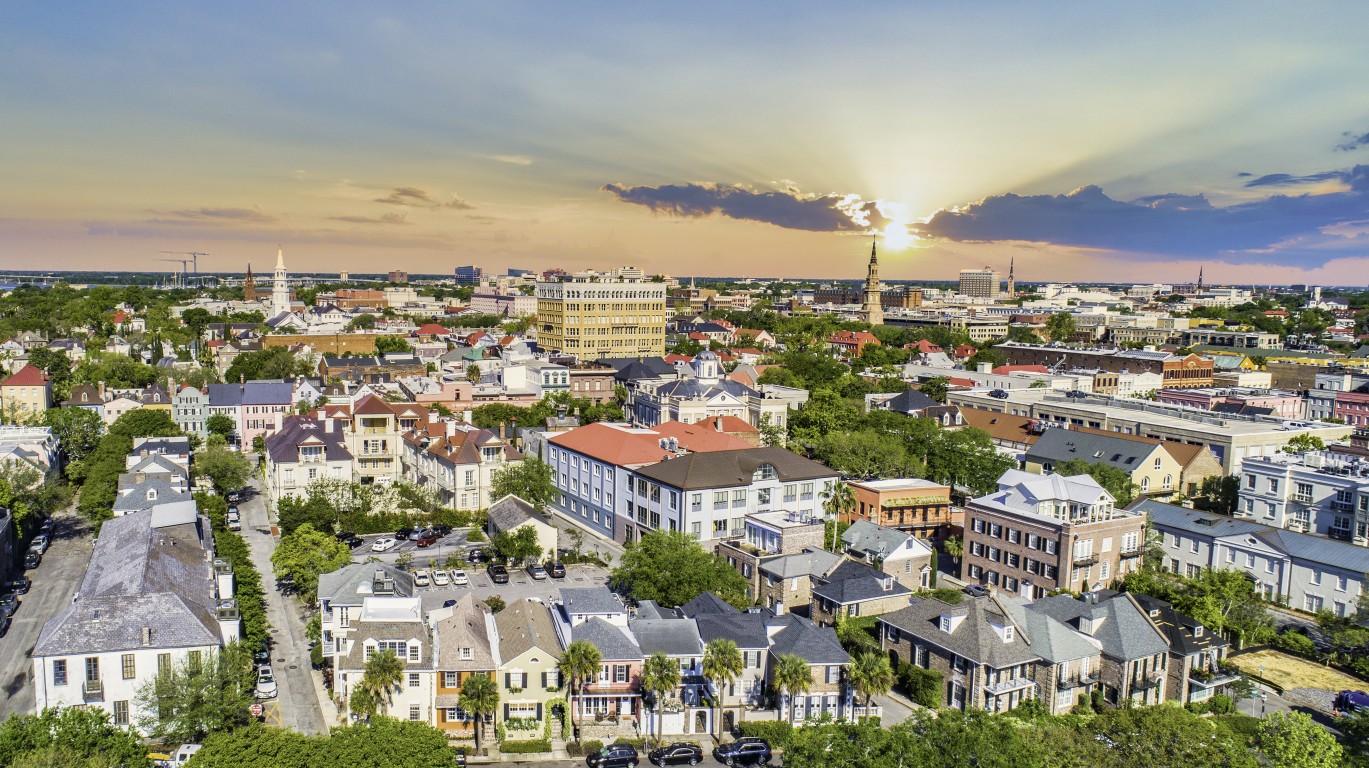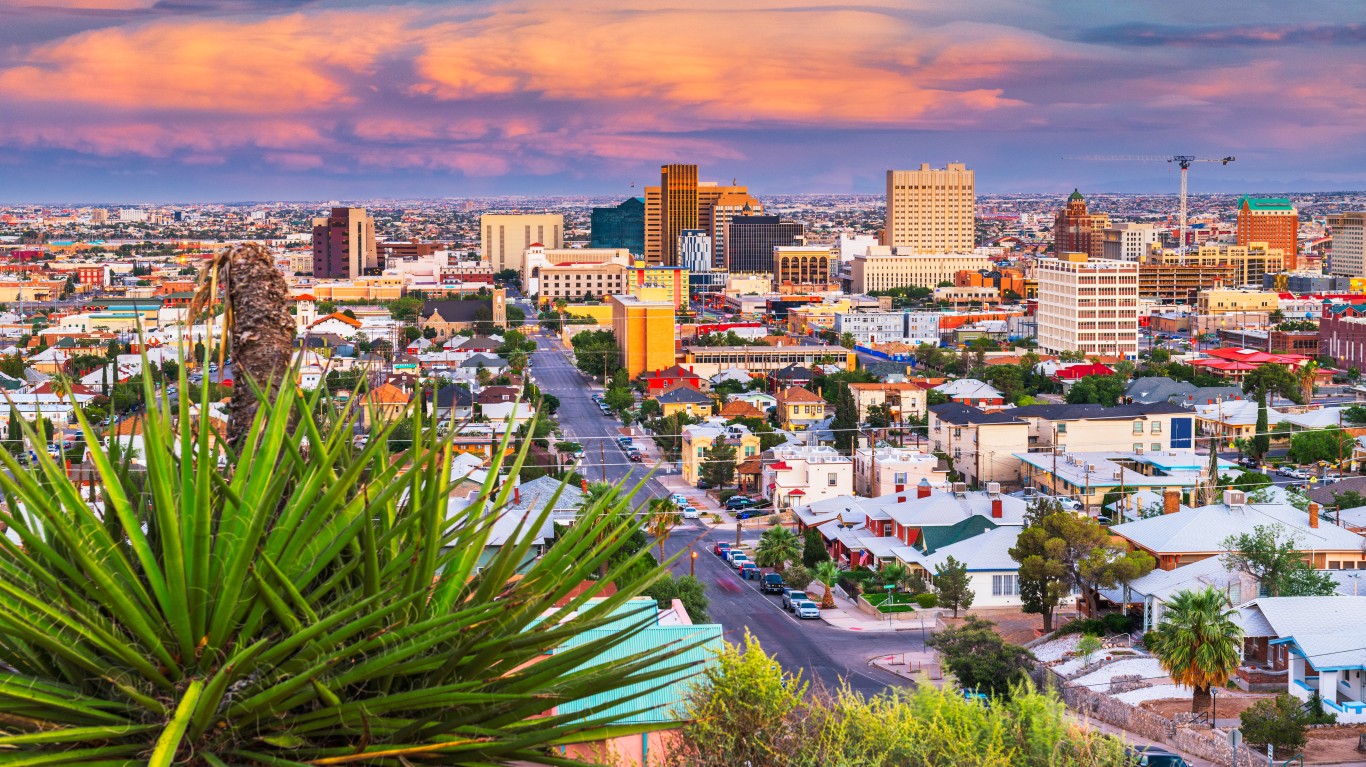Special Report
States that Lost the Most People Last Year: All 50 States Ranked

Published:

Population growth in the U.S. is starting to recover from historic lows largely related to the COVID-19 pandemic; however, the current growth rate remains lower than any seen during the 20th century. Between July 1, 2020 and July 1, 2021, the population rose by 0.1% — the lowest rate in the history of the United States. Deaths related to COVID-19 combined with closed borders during the pandemic that led to a halt in immigration were large factors.
Between 2021 and 2022, the growth rate rose to 0.4%, with an uptick in migration from abroad accounting for much of the increase. Over 1 million migrants moved to the U.S. during this period. By state, the three most populous states had the highest levels of international migration, with Florida and California each receiving over 125,000 migrants, and Texas receiving over 118,000. (These are the states where the most people are immigrants.)
Despite the higher numbers of international immigrants moving to California, the state recorded a net migration loss, as over 343,000 residents left the state. Other states with net migration losses include Illinois, Louisiana, New Jersey, and New York.
Considering natural causes, in 23 states, including Pennsylvania, Michigan, Ohio, and West Virginia, there was a natural population loss, where the number of deaths in the state exceeded the number of births. (These are the states where deaths are outpacing births.)
To determine the states that lost the most people, 24/7 Wall St. reviewed data on population changes from the U.S. Census Bureau’s Population and Housing Unit Estimates program. States were ranked based on total population change from July 1, 2021 to July 1, 2022. Supplemental data on population changes due to net migration and due to natural change (births less deaths) also came from the Census Bureau PHUE.
Between July 1, 2021 and July 1, 2022, the population declined in 18 U.S. states, with 14 recording some population loss due to migration and eight recording some population loss due to natural causes. In four states — Rhode Island, Mississippi, Pennsylvania, and Oregon — the population loss was due to both factors.
For the top three states that lost the most people, however, domestic migration out of state was the contributing factor to population loss rather than natural change. New York, the state where the population declined the most, lost 299,557 people to domestic migration, while Illinois lost 141,656, and Louisiana lost 46,672. (These are America’s 19 fastest-shrinking big cities.)
Here are the states that lost the most people.

50. Florida
> Population change, July 1, 2021 to July 1, 2022: +1.9% (+416,754 people)
> Population change due to net migration: +2.0% (the highest)
> Population change due to natural change: -0.2% (6th lowest)
> Total population, July 1, 2022: 22,244,823 (3rd highest)

49. Idaho
> Population change, July 1, 2021 to July 1, 2022: +1.8% (+34,719 people)
> Population change due to net migration: +1.6% (4th highest)
> Population change due to natural change: +0.2% (11th highest)
> Total population, July 1, 2022: 1,939,033 (13th lowest)

48. South Carolina
> Population change, July 1, 2021 to July 1, 2022: +1.7% (+89,368 people)
> Population change due to net migration: +1.8% (2nd highest)
> Population change due to natural change: -0.1% (13th lowest)
> Total population, July 1, 2022: 5,282,634 (23rd highest)

47. Texas
> Population change, July 1, 2021 to July 1, 2022: +1.6% (+470,708 people)
> Population change due to net migration: +1.2% (10th highest)
> Population change due to natural change: +0.4% (3rd highest)
> Total population, July 1, 2022: 30,029,572 (2nd highest)

46. South Dakota
> Population change, July 1, 2021 to July 1, 2022: +1.5% (+13,660 people)
> Population change due to net migration: +1.3% (8th highest)
> Population change due to natural change: +0.2% (7th highest)
> Total population, July 1, 2022: 909,824 (5th lowest)

45. Montana
> Population change, July 1, 2021 to July 1, 2022: +1.5% (+16,640 people)
> Population change due to net migration: +1.6% (3rd highest)
> Population change due to natural change: -0.2% (11th lowest)
> Total population, July 1, 2022: 1,122,867 (8th lowest)

44. Delaware
> Population change, July 1, 2021 to July 1, 2022: +1.4% (+13,589 people)
> Population change due to net migration: +1.4% (5th highest)
> Population change due to natural change: -0.1% (21st lowest)
> Total population, July 1, 2022: 1,018,396 (6th lowest)

43. Arizona
> Population change, July 1, 2021 to July 1, 2022: +1.3% (+94,320 people)
> Population change due to net migration: +1.3% (7th highest)
> Population change due to natural change: +0.0% (24th lowest)
> Total population, July 1, 2022: 7,359,197 (14th highest)

42. North Carolina
> Population change, July 1, 2021 to July 1, 2022: +1.3% (+133,088 people)
> Population change due to net migration: +1.2% (9th highest)
> Population change due to natural change: +0.1% (20th highest)
> Total population, July 1, 2022: 10,698,973 (9th highest)

41. Utah
> Population change, July 1, 2021 to July 1, 2022: +1.2% (+41,687 people)
> Population change due to net migration: +0.5% (18th highest)
> Population change due to natural change: +0.7% (the highest)
> Total population, July 1, 2022: 3,380,800 (21st lowest)

40. Tennessee
> Population change, July 1, 2021 to July 1, 2022: +1.2% (+82,988 people)
> Population change due to net migration: +1.3% (6th highest)
> Population change due to natural change: -0.1% (14th lowest)
> Total population, July 1, 2022: 7,051,339 (15th highest)

39. Georgia
> Population change, July 1, 2021 to July 1, 2022: +1.2% (+124,847 people)
> Population change due to net migration: +1.0% (12th highest)
> Population change due to natural change: +0.1% (16th highest)
> Total population, July 1, 2022: 10,912,876 (8th highest)

38. Nevada
> Population change, July 1, 2021 to July 1, 2022: +1.0% (+31,370 people)
> Population change due to net migration: +1.0% (13th highest)
> Population change due to natural change: +0.0% (25th lowest)
> Total population, July 1, 2022: 3,177,772 (19th lowest)

37. Oklahoma
> Population change, July 1, 2021 to July 1, 2022: +0.7% (+28,575 people)
> Population change due to net migration: +0.8% (14th highest)
> Population change due to natural change: -0.1% (20th lowest)
> Total population, July 1, 2022: 4,019,800 (23rd lowest)

36. Maine
> Population change, July 1, 2021 to July 1, 2022: +0.6% (+8,102 people)
> Population change due to net migration: +1.0% (11th highest)
> Population change due to natural change: -0.4% (2nd lowest)
> Total population, July 1, 2022: 1,385,340 (9th lowest)

35. Washington
> Population change, July 1, 2021 to July 1, 2022: +0.6% (+45,041 people)
> Population change due to net migration: +0.4% (19th highest)
> Population change due to natural change: +0.2% (14th highest)
> Total population, July 1, 2022: 7,785,786 (13th highest)

34. Arkansas
> Population change, July 1, 2021 to July 1, 2022: +0.6% (+17,515 people)
> Population change due to net migration: +0.7% (16th highest)
> Population change due to natural change: -0.1% (15th lowest)
> Total population, July 1, 2022: 3,045,637 (18th lowest)

33. New Hampshire
> Population change, July 1, 2021 to July 1, 2022: +0.6% (+7,726 people)
> Population change due to net migration: +0.7% (15th highest)
> Population change due to natural change: -0.1% (12th lowest)
> Total population, July 1, 2022: 1,395,231 (10th lowest)

32. Colorado
> Population change, July 1, 2021 to July 1, 2022: +0.5% (+28,629 people)
> Population change due to net migration: +0.3% (24th highest)
> Population change due to natural change: +0.2% (8th highest)
> Total population, July 1, 2022: 5,839,926 (21st highest)

31. Alabama
> Population change, July 1, 2021 to July 1, 2022: +0.5% (+24,450 people)
> Population change due to net migration: +0.7% (17th highest)
> Population change due to natural change: -0.2% (8th lowest)
> Total population, July 1, 2022: 5,074,296 (24th highest)

30. Wyoming
> Population change, July 1, 2021 to July 1, 2022: +0.3% (+1,898 people)
> Population change due to net migration: +0.4% (20th highest)
> Population change due to natural change: -0.1% (19th lowest)
> Total population, July 1, 2022: 581,381 (the lowest)

29. Virginia
> Population change, July 1, 2021 to July 1, 2022: +0.3% (+26,254 people)
> Population change due to net migration: +0.2% (24th lowest)
> Population change due to natural change: +0.1% (17th highest)
> Total population, July 1, 2022: 8,683,619 (12th highest)

28. Indiana
> Population change, July 1, 2021 to July 1, 2022: +0.3% (+19,505 people)
> Population change due to net migration: +0.3% (23rd highest)
> Population change due to natural change: +0.0% (25th highest)
> Total population, July 1, 2022: 6,833,037 (17th highest)

27. Nebraska
> Population change, July 1, 2021 to July 1, 2022: +0.2% (+4,369 people)
> Population change due to net migration: +0.0% (17th lowest)
> Population change due to natural change: +0.3% (6th highest)
> Total population, July 1, 2022: 1,967,923 (14th lowest)

26. Wisconsin
> Population change, July 1, 2021 to July 1, 2022: +0.2% (+12,438 people)
> Population change due to net migration: +0.3% (25th highest)
> Population change due to natural change: +0.0% (23rd lowest)
> Total population, July 1, 2022: 5,892,539 (20th highest)

25. North Dakota
> Population change, July 1, 2021 to July 1, 2022: +0.2% (+1,327 people)
> Population change due to net migration: -0.2% (12th lowest)
> Population change due to natural change: +0.4% (4th highest)
> Total population, July 1, 2022: 779,261 (4th lowest)

24. Missouri
> Population change, July 1, 2021 to July 1, 2022: +0.1% (+8,134 people)
> Population change due to net migration: +0.2% (25th lowest)
> Population change due to natural change: -0.1% (18th lowest)
> Total population, July 1, 2022: 6,177,957 (18th highest)

23. Kentucky
> Population change, July 1, 2021 to July 1, 2022: +0.1% (+5,721 people)
> Population change due to net migration: +0.3% (22nd highest)
> Population change due to natural change: -0.2% (5th lowest)
> Total population, July 1, 2022: 4,512,310 (25th lowest)

22. Minnesota
> Population change, July 1, 2021 to July 1, 2022: +0.1% (+5,713 people)
> Population change due to net migration: -0.1% (15th lowest)
> Population change due to natural change: +0.2% (10th highest)
> Total population, July 1, 2022: 5,717,184 (22nd highest)

21. Iowa
> Population change, July 1, 2021 to July 1, 2022: +0.1% (+2,828 people)
> Population change due to net migration: +0.1% (18th lowest)
> Population change due to natural change: +0.0% (21st highest)
> Total population, July 1, 2022: 3,200,517 (20th lowest)

20. Connecticut
> Population change, July 1, 2021 to July 1, 2022: +0.1% (+2,850 people)
> Population change due to net migration: +0.1% (20th lowest)
> Population change due to natural change: +0.0% (23rd highest)
> Total population, July 1, 2022: 3,626,205 (22nd lowest)

19. Vermont
> Population change, July 1, 2021 to July 1, 2022: +0.0% (+92 people)
> Population change due to net migration: +0.3% (21st highest)
> Population change due to natural change: -0.3% (3rd lowest)
> Total population, July 1, 2022: 647,064 (2nd lowest)

18. Kansas
> Population change, July 1, 2021 to July 1, 2022: +0.0% (-772 people)
> Population change due to net migration: -0.1% (16th lowest)
> Population change due to natural change: +0.1% (19th highest)
> Total population, July 1, 2022: 2,937,150 (16th lowest)

17. Michigan
> Population change, July 1, 2021 to July 1, 2022: +0.0% (-3,391 people)
> Population change due to net migration: +0.1% (21st lowest)
> Population change due to natural change: -0.1% (16th lowest)
> Total population, July 1, 2022: 10,034,113 (10th highest)

16. New Jersey
> Population change, July 1, 2021 to July 1, 2022: -0.1% (-6,262 people)
> Population change due to net migration: -0.3% (8th lowest)
> Population change due to natural change: +0.2% (9th highest)
> Total population, July 1, 2022: 9,261,699 (11th highest)

15. Ohio
> Population change, July 1, 2021 to July 1, 2022: -0.1% (-8,284 people)
> Population change due to net migration: +0.1% (23rd lowest)
> Population change due to natural change: -0.2% (10th lowest)
> Total population, July 1, 2022: 11,756,058 (7th highest)

14. Alaska
> Population change, July 1, 2021 to July 1, 2022: -0.1% (-599 people)
> Population change due to net migration: -0.5% (6th lowest)
> Population change due to natural change: +0.4% (2nd highest)
> Total population, July 1, 2022: 733,583 (3rd lowest)

13. Massachusetts
> Population change, July 1, 2021 to July 1, 2022: -0.1% (-7,716 people)
> Population change due to net migration: -0.2% (11th lowest)
> Population change due to natural change: +0.1% (18th highest)
> Total population, July 1, 2022: 6,981,974 (16th highest)

12. New Mexico
> Population change, July 1, 2021 to July 1, 2022: -0.2% (-3,333 people)
> Population change due to net migration: +0.1% (19th lowest)
> Population change due to natural change: -0.2% (4th lowest)
> Total population, July 1, 2022: 2,113,344 (15th lowest)

11. Maryland
> Population change, July 1, 2021 to July 1, 2022: -0.2% (-9,950 people)
> Population change due to net migration: -0.3% (7th lowest)
> Population change due to natural change: +0.2% (12th highest)
> Total population, July 1, 2022: 6,164,660 (19th highest)

10. California
> Population change, July 1, 2021 to July 1, 2022: -0.3% (-113,649 people)
> Population change due to net migration: -0.6% (5th lowest)
> Population change due to natural change: +0.3% (5th highest)
> Total population, July 1, 2022: 39,029,342 (the highest)
9. Rhode Island
> Population change, July 1, 2021 to July 1, 2022: -0.3% (-3,251 people)
> Population change due to net migration: -0.2% (10th lowest)
> Population change due to natural change: -0.1% (22nd lowest)
> Total population, July 1, 2022: 1,093,734 (7th lowest)

8. Pennsylvania
> Population change, July 1, 2021 to July 1, 2022: -0.3% (-40,051 people)
> Population change due to net migration: -0.1% (14th lowest)
> Population change due to natural change: -0.2% (7th lowest)
> Total population, July 1, 2022: 12,972,008 (5th highest)
7. Mississippi
> Population change, July 1, 2021 to July 1, 2022: -0.3% (-9,529 people)
> Population change due to net migration: -0.1% (13th lowest)
> Population change due to natural change: -0.2% (9th lowest)
> Total population, July 1, 2022: 2,940,057 (17th lowest)

6. Oregon
> Population change, July 1, 2021 to July 1, 2022: -0.4% (-16,164 people)
> Population change due to net migration: -0.2% (9th lowest)
> Population change due to natural change: -0.1% (17th lowest)
> Total population, July 1, 2022: 4,240,137 (24th lowest)

5. Hawaii
> Population change, July 1, 2021 to July 1, 2022: -0.5% (-6,958 people)
> Population change due to net migration: -0.7% (4th lowest)
> Population change due to natural change: +0.2% (15th highest)
> Total population, July 1, 2022: 1,440,196 (11th lowest)

4. West Virginia
> Population change, July 1, 2021 to July 1, 2022: -0.6% (-10,370 people)
> Population change due to net migration: +0.1% (22nd lowest)
> Population change due to natural change: -0.7% (the lowest)
> Total population, July 1, 2022: 1,775,156 (12th lowest)

3. Louisiana
> Population change, July 1, 2021 to July 1, 2022: -0.8% (-36,857 people)
> Population change due to net migration: -0.8% (3rd lowest)
> Population change due to natural change: +0.0% (24th highest)
> Total population, July 1, 2022: 4,590,241 (25th highest)

2. Illinois
> Population change, July 1, 2021 to July 1, 2022: -0.8% (-104,437 people)
> Population change due to net migration: -0.9% (2nd lowest)
> Population change due to natural change: +0.0% (22nd highest)
> Total population, July 1, 2022: 12,582,032 (6th highest)

1. New York
> Population change, July 1, 2021 to July 1, 2022: -0.9% (-180,341 people)
> Population change due to net migration: -1.1% (the lowest)
> Population change due to natural change: +0.2% (13th highest)
> Total population, July 1, 2022: 19,677,151 (4th highest)
Start by taking a quick retirement quiz from SmartAsset that will match you with up to 3 financial advisors that serve your area and beyond in 5 minutes, or less.
Each advisor has been vetted by SmartAsset and is held to a fiduciary standard to act in your best interests.
Here’s how it works:
1. Answer SmartAsset advisor match quiz
2. Review your pre-screened matches at your leisure. Check out the advisors’ profiles.
3. Speak with advisors at no cost to you. Have an introductory call on the phone or introduction in person and choose whom to work with in the future
Thank you for reading! Have some feedback for us?
Contact the 24/7 Wall St. editorial team.